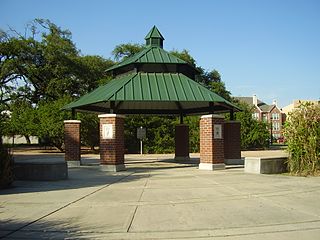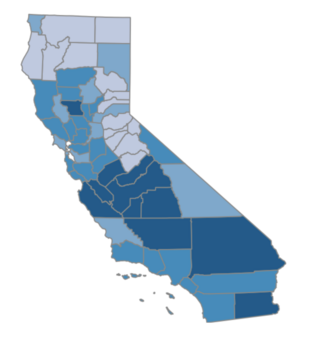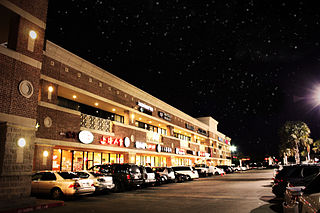Related Research Articles

The Chinese Exclusion Act was a United States federal law signed by President Chester A. Arthur on May 6, 1882, prohibiting all immigration of Chinese laborers for 10 years. The law excluded merchants, teachers, students, travelers, and diplomats. Building on the earlier Page Act of 1875, which banned Chinese women from migrating to the United States, the Chinese Exclusion Act was the only law ever implemented to prevent all members of a specific ethnic or national group from immigrating to the United States.

Fisher County is a county located in the U.S. state of Texas. As of the 2020 census, its population was 3,672. The county seat is Roby. The county was created in 1876 and later organized in 1886. It is named for Samuel Rhoads Fisher, a signer of the Texas Declaration of Independence and a Secretary of the Navy of the Republic of Texas. Fisher County was one of 30 prohibition, or entirely dry, counties in Texas, but is now a fully wet county.

The Southern United States is a geographic and cultural region of the United States of America. It is between the Atlantic Ocean and the Western United States, with the Midwestern and Northeastern United States to its north and the Gulf of Mexico and Mexico to its south.

Mexican Americans are Americans of full or partial Mexican heritage. In 2019, Mexican Americans comprised 11.3% of the US population and 61.5% of all Hispanic and Latino Americans. In 2019, 71% of Mexican Americans were born in the United States, though they make up 53% of the total population of foreign-born Latino Americans and 25% of the total foreign-born population. The United States is home to the second-largest Mexican community in the world, behind only Mexico. Most Mexican Americans reside in the Southwest.

The history of Chinese Americans or the history of ethnic Chinese in the United States includes three major waves of Chinese immigration to the United States, beginning in the 19th century. Chinese immigrants in the 19th century worked in the California Gold Rush of the 1850s and the Central Pacific Railroad in the 1860s. They also worked as laborers in Western mines. They suffered racial discrimination at every level of society. The white people were stirred to anger by the "yellow peril" rhetoric. Despite provisions for equal treatment of Chinese immigrants in the 1868 Burlingame Treaty between the US and China, political and labor organizations rallied against "cheap Chinese labor."

Indonesian Americans are migrants from the multiethnic country of Indonesia to the United States, and their U.S.-born descendants. In both the 2000 and 2010 United States census, they were the 15th largest group of Asian Americans recorded in the United States as well as one of the fastest growing.
Pacific Islander Americans are Americans who are of Pacific Islander ancestry. For its purposes, the United States census also counts Indigenous Australians as part of this group.

The history of immigration to the United States details the movement of people to the United States, from the colonial era to the present. The United States experienced successive waves of immigration, particularly from Europe, and later from Asia and Latin America. Colonial era immigrants often repaid the cost of transoceanic transportation by becoming indentured servants where the new employer paid the ship's captain. Starting in the late 19th century, immigration was restricted from China and Japan. In the 1920s, restrictive immigration quotas were imposed, although political refugees had special status. Numerical restrictions ended in 1965. In recent years, the largest numbers have come from Asia and Central America.

Chinatowns are enclaves of Chinese people outside of China. The first Chinatown in the United States was San Francisco's Chinatown in 1848, and many other Chinatowns were established in the 19th century by the Chinese diaspora on the West Coast. By 1875, Chinatowns had emerged in eastern cities such as New York City, Boston, and Philadelphia. The Chinese Exclusion Act of 1882 barred Chinese immigration to the United States, but the Magnuson Act of 1943 repealed it, and the population of Chinatowns began to rise again. In the 2010s, the downturn in the U.S. economy caused many Chinese Americans to return to China.

The demographics of Filipino Americans describe a heterogeneous group of people in the United States who trace their ancestry to the Philippines. As of the 2010 Census, there were 3.4 million Filipino Americans, including Multiracial Americans who were part Filipino living in the US; in 2011 the United States Department of State estimated the population at four million. Filipino Americans constitute the second-largest population of Asian Americans, and the largest population of Overseas Filipinos.

This article discusses the history of Vietnamese Americans and Vietnamese immigrants in Houston, Texas, and its environs. Vietnamese immigration has occurred in Greater Houston, including Fort Bend County and Harris County, since 1975, after the Vietnam War ended and refugees began coming to the United States.

Hispanic and Latino Californians are residents of the state of California who are of Hispanic or Latino ancestry. As of the 2020 U.S. Census, Hispanics and Latinos of any race were 39.4% of the state's population, making it the largest ethnicity in California.

The Houston area population includes a large number of people with Chinese ancestral backgrounds. According to the American Community Survey, as of 2013, Greater Houston has 72,320 residents of Chinese origin.
The 1990 United States census and 2000 United States census found that non-Hispanic whites were becoming a minority in Los Angeles. Estimates for the 2010 United States census results find Latinos to be approximately half (47-49%) of the city's population, growing from 40% in 2000 and 30-35% in 1990 census.

As of the 2020 United States census, there were 7,637,387 people. The racial makeup of the MSA was 50.2% White, 15.4% African American, 0.6% Native American, 5.9% Asian, 0.1% Pacific Islander, 10.0% from other races, and 2.4% from two or more races. Hispanic or Latino of any race were 27.5% of the population.
The Dallas-Fort Worth (DFW) area has a population of Chinese Americans. In the second half of the 19th century, the area became permanently settled by non-Native Americans, and citizens of Chinese descent began to make the area their home as well. In modern times, the main population of Chinese Americans is scattered around the northern suburbs of the City of Dallas.
The 2021 United States Census reported that San Francisco had a population of 815,201—an increase from the 2010 Census count of 805,235. With a population density of 18,633 per square mile (7,194/km2), San Francisco is the second-most densely populated major American city, behind only New York.
Central Asians in the United States are Americans with ancestry from Central Asia. They include Kazakh, Kyrgyz, Tajik, Turkmen, and Uzbek individuals. People of Afghan, Baloch, and Uyghur descent are also sometimes classified as Central Asians. The United States census does not mention Central Asians under any category.

Houston has large populations of immigrants from Asia. In addition, the city has the largest Vietnamese American population in Texas and third-largest in the United States as of 2004.
References
- Rhoads, Edward J.M (July 1977). "The Chinese in Texas". Southwestern Historical Quarterly . 81 (1): 1–36. JSTOR 30238491.